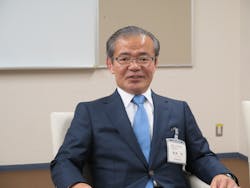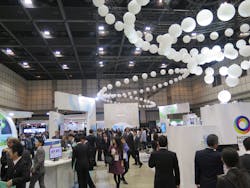Business Forum: Photons are good business -- An interview with Akira Hiruma
In early November 2018, I visited Japan at the invitation of Hamamatsu Photonics to attend the three-day Photon Fair, the company’s big event looking at its technologies and vision for the future. The Fair is held every five years near its headquarters in Hamamatsu City, about 150 miles southwest of Tokyo. In addition to thousands of customers, suppliers, and students who attended, the event was open to the public for one day to show the many technologies just emerging from the company’s research labs and how these technologies might impact fields ranging from the life sciences to transportation and manufacturing.
There were dozens of technical seminars and several keynote speakers, including Ken Koibuchi, executive general manager, Advanced R&D and Engineering Company of Toyota Motor Corporation, and Bruce Tromberg from UC Irvine (and incoming director of the National Institute of Biomedical Imaging and Bioengineering), who spoke on wearable and bedside devices for personalized health. The president and CEO of Hamamatsu Photonics, Akira Hiruma, gave the opening keynote about the next generation of photonics-based innovations. I had the pleasure of interviewing him shortly after his talk. A graduate of Rutgers University and having spent 30 years working and later running the U.S. subsidiary of Hamamatsu Photonics, he had much to say about succeeding as a photonics component supplier.Conard Holton: Walking around the displays at Photon Fair, I’ve seen many fascinating technologies—several new to me. What is your personal favorite?
Akira Hiruma: My personal favorite has to be the iPMSELs (integrable phase-modulating surface-emitting lasers; see “Phase-modulating semiconductor laser projects 2D beam patterns without HOEs or SLMs,” page 20)—they are really exciting devices with many promising applications. It’s not only the device itself that’s interesting, but how it was developed. Usually in our Central Research Lab, the head of the group decides which projects to pursue. But in this case, we asked our younger engineers, under 40 years, to propose some ideas that could change the world. And they came up with this project. Our advantage is that we produce both the laser and the spatial light modulator, so we can put them together in one package. So yes, we are very excited and ambitious for it.
CH: The demo application your engineer showed me was a sort of movie—that’s pretty futuristic, but is it a possibility?
AH: That is really our method, you know. We set a goal for the research that is very high—that we will create a 3D display without glass. It’s very difficult, but on the way there you will find other applications. You say “futuristic,” right? That’s the kind of thinking and ability that I want our researchers to have: set a high goal and, while we’re working on it, find a new application they don’t even know exists. Maybe it’s laser scalpels with capsule endoscopes—we don’t know.
CH: How do you balance work on the applications with researching the core technologies?
AH: I’m always telling people that usually, industry is like a pyramid—some big company is on top, and then second- and third-tier suppliers support it. But the photonics applications industries are a sort of inverted pyramid and we are at the bottom—below customers who make modules utilizing our devices and then there are system builders utilizing the modules. At the top, the application industry becomes huge. We are only about a $1.2 billion company, but for example, 40% of our revenue comes from medical device manufacturers, which is a huge industry. That’s why I say our most important avenue of growth is widening the number of applications.
Although we are at the bottom of the pyramid, the performance of our devices directly affects the performance of our customers’ systems. And for system builders to advance their performance, they need our help, which requires research.
CH: So, how do you meet customers’ needs?
AH: We must have day-to-day conversations, of course, but customers don’t always know their future needs. I think one answer is with some of the startup companies at universities, because they are doing something that industry is not—trying to find a new way. So, to invest in these companies, we have created a corporate venture capital fund of $10 million and our investments are for $100,000. It’s small—but for a startup, very valuable seed funding. If the application is very interesting and the startup agreeable, we would like to send an engineer to work with it.
Hamamatsu Photonics began as a venture startup company in 1953, but now our new employees think we are a big company—that’s not the mindset that I want our young engineers to have! I want them to experience the feeling we had 65 years ago. If you’re lucky, one in 10 new ventures will succeed. It’s okay to fail. You can come back to help lead internal venture activities.
CH: Last year, you acquired UV light-source maker Energetiq Technology. Do you plan to make more acquisitions?
AH: We are looking at a lot of investment opportunities, but we don’t want to rely on outside investments. We also want to create an internal startup atmosphere. Although Hamamatsu Photonics is mainly a Japanese company that sells globally, I want to broaden the thinking of our researchers and engineers. “Get out and see what’s going on in the U.S. or Europe!”
CH: Many of the challenges you see appear to be related to instilling a sense of entrepreneurship—is that the case?
AH: Yes, but I don’t want to be misunderstood. We can make these investments in entrepreneurship because we are making a good profit with our core businesses. So, we keep investing there, too. For example, we recently made a $100 million investment in a compound semiconductor manufacturing facility. Several of our divisions will be able to use it. We want to keep improving our ability to manufacture the best and most cost-effective products. If the lidar market really takes off, we will have to greatly increase our manufacturing capability, and this new facility is designed to accommodate such growth.
CH: Are you thinking of making the entire lidar system?
AH: No, we want to be making the key enabling technologies: we have the lasers, the mirrors, and the sensors. It’s not only for automotive, but also for drones. We are not committed to any one wavelength—it depends on the customer.
CH: Finally, you approach the future with a very long-term view. What are the biggest challenges on your horizon?
AH: Near- and long-term, we are always an engineering company. We are very good at research and development, and producing the best products, at a high price. We have to change so that we make very reliable, cost-effective products with faster delivery. We must also be aware that, in the future, software is improving very quickly and some of the deficiencies of lower-quality sensors could be compensated by software and may be sufficient for customers’ needs in the future. Therefore, we need to go into the deep learning (artificial intelligence) field ourselves not to develop AI architecture, but to learn to utilize it to our advantage.

Conard Holton
Conard Holton has 25 years of science and technology editing and writing experience. He was formerly a staff member and consultant for government agencies such as the New York State Energy Research and Development Authority and the International Atomic Energy Agency, and engineering companies such as Bechtel. He joined Laser Focus World in 1997 as senior editor, becoming editor in chief of WDM Solutions, which he founded in 1999. In 2003 he joined Vision Systems Design as editor in chief, while continuing as contributing editor at Laser Focus World. Conard became editor in chief of Laser Focus World in August 2011, a role in which he served through August 2018. He then served as Editor at Large for Laser Focus World and Co-Chair of the Lasers & Photonics Marketplace Seminar from August 2018 through January 2022. He received his B.A. from the University of Pennsylvania, with additional studies at the Colorado School of Mines and Medill School of Journalism at Northwestern University.

